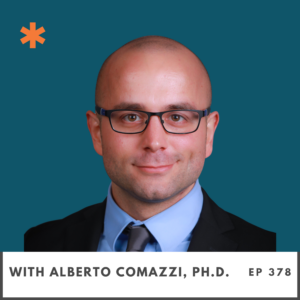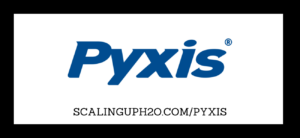“It is a team effort to protect public health from Legionella.” – Alberto Comazzi, Ph.D.

We are excited to welcome back Alberto Comazzi, Ph.D. of Sanipur US, for his third appearance on the Scaling UP! H2O Podcast. As an expert in waterborne pathogens, Alberto shares his invaluable insights and experiences about Legionella to help our audience stay informed and proactive in managing water systems. In this episode, we cover a wide range of topics from handling positive Legionella tests to the effectiveness of monochloramine in disinfection. Let’s dive into the key points of our discussion.
How do you handle a call from a client panicking about their first positive Legionella test?
Alberto advises us to stay calm and follow the pre-established plan outlined in the Water Management Plan (WMP). First, review the WMP to understand the specific steps to take for this scenario. Consider the positivity rates and the location where Legionella was found. By following the agreed-upon plan, you can address the client’s concerns effectively and ensure proper action is taken.
Why have we seen Legionella increase by nearly ten times over the past few years?
“5-6 years ago there wasn’t much information about Legionella, and today so many people are interested in this field which protects public health.” – Alberto Comazzi, PhD
Dr. Comazzi highlights two key factors behind the significant rise in Legionella cases:
1. Enhanced Water Testing and Awareness:
The past few years have seen a substantial increase in both awareness and testing for Legionella. Healthcare professionals are now more informed about the risks of Legionella and are conducting more tests. Since 2017, the requirement for Water Management Plans (WMPs) in healthcare facilities has led to more comprehensive water testing, contributing to the rise in detected cases.
2. Increased Water Age in Buildings:
Efforts to conserve water, which have important environmental benefits such as saving energy and reducing costs, have inadvertently led to higher water age in building systems. When water remains in systems for longer periods, it can lead to reduced disinfectant levels and higher water temperatures—conditions that promote Legionella growth. While water conservation is crucial, balancing it with effective Legionella control measures is essential for maintaining public health.
By understanding these factors, we can better address and mitigate Legionella risks, ensuring a safer environment for everyone.
What advice do you have for those putting together a WMP but who doesn’t have the ASSE 1280 Certification?
Get Certified or Seek Expert Help:
Creating a comprehensive Water Management Plan (WMP) can be complex. While obtaining ASSE 1280 certification is highly recommended, you can also consider hiring a consultant to help you draft your plan. However, it’s crucial to ensure that you execute and document the plan effectively. Proper training for facility operators on temperature control, flushing procedures, disinfectant management, and documentation is essential.
“A Water Management Plan that’s just sitting on the shelf isn’t doing anyone any good. If no one implements the plan, it is useless.” Dr. Alberto Comazzi emphasizes, “Proactive measures are better and more cost-effective than reactive ones.” With upcoming due diligence plans addressing various waterborne pathogens, being prepared is key.
Who has responsibility when it comes to municipal water?
Alberto reminds us that there is a division between the municipality and the building.
Municipal Water Responsibility:
Municipal water suppliers are responsible for providing water that meets regulatory standards up to the distribution system. They conduct primary disinfection to inactivate most microorganisms and secondary disinfection to maintain a residual disinfectant. However, there are no enforceable limits for Legionella in the municipal water supply, and testing for Legionella is not required.
Building-Level Responsibility:
Once water leaves the municipal system and enters a building, the responsibility for water safety, including Legionella control, falls to the building owner or manager. Building environments, with their complex plumbing systems, cooling towers, and hot water systems, can foster Legionella growth. Therefore, effective management and control measures at the building level are crucial for ensuring water safety.
Monochloramine vs. Chlorine: Which is better Disinfection and Legionella Control in Building Water Systems?
Alberto highlights the advantages of monochloramine over chlorine:
Case Study Results: A case study in San Francisco showed that switching from chlorine to monochloramine in the municipal water supply significantly reduced Legionella positivity rates in buildings—from 60% to 3-4%. This demonstrates the effectiveness of monochloramine in providing better overall disinfection due to its stability and ability to maintain higher disinfectant levels in building plumbing systems.
Comparison with Chlorine: Monochloramine, unlike chlorine, is less reactive with organic materials in water and thus produces fewer regulated disinfection byproducts. It is a more stable disinfectant, which makes it less likely to form harmful byproducts while still providing effective disinfection.
Effectiveness in Building Systems: In building water systems, especially those with low water usage or higher temperatures, monochloramine’s stability is advantageous. It provides a more consistent and longer-lasting disinfectant presence throughout the system, reaching all areas effectively, which is crucial for preventing Legionella growth.
What long-term effects on sustainability and equipment should we consider when balancing water conservation with the use of additional disinfectants in buildings?
Alberto outlines key considerations:
Corrosion Impact: When installing additional disinfectants, consider their potential to corrode plumbing systems. High levels of corrosive disinfectants can damage plumbing, so it’s crucial to balance disinfection effectiveness with the preservation of the building’s infrastructure.
Water Quality Effects: Assess whether the chosen disinfectant might increase other harmful molecules in the water. Evaluate disinfection efficacy not only in the lab but also in real-world building settings to ensure it does not negatively impact overall water quality.
Review Published Data: Refer to peer-reviewed literature and research from credible sources like the EPA to verify the long-term effects of disinfectants on water systems. Reliable data helps ensure that the disinfectant does not introduce unintended consequences and maintains water quality over time.
How did monochloramine perform in controlling Pseudomonas compared to traditional methods?
In a case study, monochloramine was implemented in facilities with Pseudomonas issues and proved effective in reducing colonization. “Unlike short-term solutions like flushing and hyperchlorination, monochloramine’s stability allowed it to reach all parts of the distribution system, providing long-term control” shares Alberto.
Timestamps
01:00 – Trace Blackmore invites you to celebrate Legionella Awareness Month
05:50 – Upcoming Events for Water Treatment Professionals
11:00 – Interview with Alberto Comazzi, Ph.D.
01:01:30 – Drop by Drop with James McDonald
Connect with Alberto Comazzi, Ph.D.
Phone: 267-326-2353
Email: a.comazzi@sanipur.com
Website: www.sanipur.com
Linkedin: /in/alberto-comazzi-phd-132637128/
company/sanipur-us-llc
Technical Paper: Emerging Waterbone Pathogens in Buildings’ Premise Plumbing System
Links Mentioned
All links mentioned on this episode can be found on our Legionella Resources page HERE
The Rising Tide Mastermind
Scaling UP! H2O Academy video courses
Drop By Drop with James
In today’s episode, I have a challenge for you. Today’s challenge is…test boiler sulfite both immediately after sampling and again an hour later on the same, open sample. Is there a difference? Why is there a difference? What would be the impact of waiting until later to run the sulfite test versus running it immediately? How might your recommendations be different? Could the way you run your test impact your results, such as how much you agitate the sample?
2024 Events for Water Professionals
Check out our Scaling UP! H2O Events Calendar where we’ve listed every event Water Treaters should be aware of by clicking HERE.

